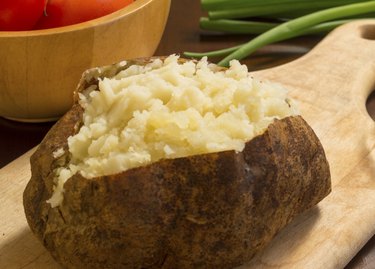
You might count calories as part of a weight-loss diet without fully understanding what a calorie is and how it works. A calorie is a unit of energy. It takes 1 "large calorie" to raise the temperature of 1 kilogram of pure water by 1 degree Celsius. Food calories are measured in large calories. Each calorie you eat has energy-producing potential for your body. Higher-calorie foods provide more energy than lower-calorie foods. Your body stores any extra calories you consume as fat.
Calories
Video of the Day
Any type of meat has more calories than virtually any type of vegetable, as long as the serving sizes weigh the same.This means that if you eat the same amount of each by weight, you'll get more energy -- or calories -- from eating meat than you will from eating vegetables. For example, a 3-ounce serving of lean sirloin steak has 180 calories, while a 3-ounce serving of green-leaf lettuce has only 13 calories.
Video of the Day
Protein
The calories in meat come from protein and fat, while vegetables generally have little to no protein and fat. Protein has 4 calories per gram. A 3-ounce, 85-gram portion of sirloin steak has 25 grams of protein, or 100 calories from protein. The same serving size of lettuce has 1 gram of protein, providing 4 calories. Protein takes time for your body to break down and digest, potentially making you feel fuller longer.
Fat
A lean, 3-ounce piece of sirloin steak has 8.2 grams of fat, including 3 grams of unhealthy saturated fat. Fat has 9 calories per gram, making it the most energy-dense source of fuel for your body. You'll get 80 calories from fat by eating 3 ounces of sirloin steak. The same serving size of lettuce offers close to zero grams of fat, yielding virtually no energy from this fuel source.
Carbohydrates
Meat has no carbohydrates, while most vegetable calories come from carbohydrates. Carbohydrates have 4 calories per gram. Your body prefers to use carbohydrates as its main source of energy, as explained by MayoClinic.com. A 3-ounce serving of lettuce provides almost 10 calories from carbohydrates. Starchier vegetables have more carbohydrates. For example, a 3-ounce portion of baked potato has 79 calories and 18 grams of carbohydrates.
Suggestions
Because meat is more calorically dense than vegetables, a 3-ounce portion of meat looks like less food but has significantly more calories than a 3-ounce portion of almost any vegetable. Pair a larger serving of vegetables with a modest 3-ounce serving of lean meat for a meal that provides energy from carbohydrates, fat and protein along with dietary fiber and essential vitamins and minerals. Add fruit, whole grains and healthy fats from oils for a balanced meal, as illustrated by the Harvard School of Public Health's Healthy Eating Plate.
- U.S. Department of Agriculture: USDA National Nutrient Database for Standard Reference
- MayoClinic.com: Carbohydrates -- How Carbs Fit Into a Healthy Diet
- Harvard School of Public Health: Healthy Eating Plate
- Bodybuilding.com; Protein, Carbs & Fat -- Everything You Need to Know About Them; Matthew Johnson; January 2003
- MedlinePlus: Protein in Diet
- MedlinePlus: Carbohydrates